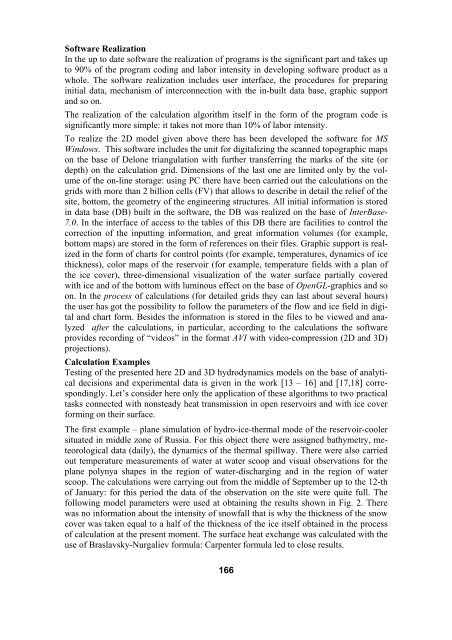Create successful ePaper yourself
Turn your PDF publications into a flip-book with our unique Google optimized e-Paper software.
Software Realization<br />
In the up to date software the realization of programs is the significant part and takes up<br />
to 90% of the program coding and labor intensity in developing software product as a<br />
whole. The software realization includes user interface, the procedures for preparing<br />
initial data, mechanism of interconnection with the in-built data base, graphic support<br />
and so on.<br />
The realization of the calculation algorithm itself in the form of the program code is<br />
significantly more simple: it takes not more than 10% of labor intensity.<br />
To realize the 2D model given above there has been developed the software for MS<br />
Windows. This software includes the unit for digitalizing the scanned topographic maps<br />
on the base of Delone triangulation with further transferring the marks of the site (or<br />
depth) on the calculation grid. Dimensions of the last one are limited only by the volume<br />
of the on-line storage: using PC there have been carried out the calculations on the<br />
grids with more than 2 billion cells (FV) that allows to describe in detail the relief of the<br />
site, bottom, the geometry of the engineering structures. All initial information is stored<br />
in data base (DB) built in the software, the DB was realized on the base of InterBase-<br />
7.0. In the interface of access to the tables of this DB there are facilities to control the<br />
correction of the inputting information, and great information volumes (for example,<br />
bottom maps) are stored in the form of references on their files. Graphic support is realized<br />
in the form of charts for control points (for example, temperatures, dynamics of ice<br />
thickness), color maps of the reservoir (for example, temperature fields with a plan of<br />
the ice cover), three-dimensional visualization of the water surface partially covered<br />
with ice and of the bottom with luminous effect on the base of OpenGL-graphics and so<br />
on. In the process of calculations (for detailed grids they can last about several hours)<br />
the user has got the possibility to follow the parameters of the flow and ice field in digital<br />
and chart form. Besides the information is stored in the files to be viewed and analyzed<br />
after the calculations, in particular, according to the calculations the software<br />
provides recording of “videos” in the format AVI with video-compression (2D and 3D)<br />
projections).<br />
Calculation Examples<br />
Testing of the presented here 2D and 3D hydrodynamics models on the base of analytical<br />
decisions and experimental data is given in the work [13 – 16] and [17,18] correspondingly.<br />
Let’s consider here only the application of these algorithms to two practical<br />
tasks connected with nonsteady heat transmission in open reservoirs and with ice cover<br />
forming on their surface.<br />
The first example – plane simulation of hydro-ice-thermal mode of the reservoir-cooler<br />
situated in middle zone of Russia. For this object there were assigned bathymetry, meteorological<br />
data (daily), the dynamics of the thermal spillway. There were also carried<br />
out temperature measurements of water at water scoop and visual observations for the<br />
plane polynya shapes in the region of water-discharging and in the region of water<br />
scoop. The calculations were carrying out from the middle of September up to the 12-th<br />
of January: for this period the data of the observation on the site were quite full. The<br />
following model parameters were used at obtaining the results shown in Fig. 2. There<br />
was no information about the intensity of snowfall that is why the thickness of the snow<br />
cover was taken equal to a half of the thickness of the ice itself obtained in the process<br />
of calculation at the present moment. The surface heat exchange was calculated with the<br />
use of Braslavsky-Nurgaliev formula: Carpenter formula led to close results.<br />
166

















